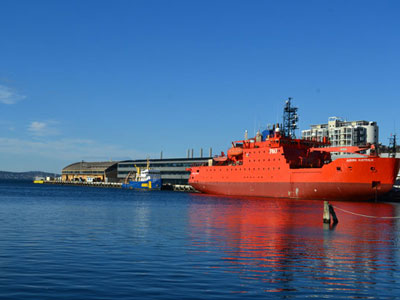

Elements of the partnership would include:
The grant is funded by the Australian Research Council (ARC) under its Special Research Initiatives scheme and includes the University of Tasmania's Institute for Marine and Antarctic Studies (IMAS) and the Australian Maritime College, the CSIRO's Oceans and Atmosphere Flagship, and the Australian Antarctic Division.
"This grant is a considerable investment to consolidate Hobart's standing as a national and international gateway to the Antarctic," University Vice-Chancellor Professor Peter Rathjen said.
"Our capacity to conduct world-class research here, and to do so in partnership with others, including Government, will create the innovation and research capacity to create the growth and economic transformation which is needed in Tasmania."
Chief Investigator for the Gateway Partnership, IMAS's Prof Richard Coleman, said funding of $24 million will complement research programs and priorities developed in Australia's Antarctic Science Strategic Plan to understand the role of Antarctica and the Southern Ocean in the global climate system.
"The Partnership will provide an important injection of funds and an exciting capacity-building development that will expand research programs in a climatically and ecologically significant region and reinforce recognition of Tasmania as a global leader in Antarctic and Southern Ocean science."
"Importantly, the Gateway funding is providing the opportunity to get more scientists to the ice. This summer alone, it is supporting ocean acidification research at Casey, marine science in the Totten and Mertz Glacier regions, and ice sheet research in Enderby Land."
"The Partnership will further establish Tasmania as a gateway for Antarctic research, education, innovation, and logistics with research on Antarctic ice sheets and ice shelves, new understanding on polar marine ecosystems and biogeochemical cycles, and the development of specialist polar marine technologies," Prof Coleman said.
The project also will involve collaboration with researchers from over ten countries. He said the Partnership will develop capabilities that will endure long after the special research funding has concluded.
Among Gateway Partnership objectives are -
Prof Coleman said Antarctica and the Southern Ocean exert immense influence on global and regional climate systems, and physical, chemical, and biological changes will confront Australians with respect to coastal communities and sea level, weather patterns and extreme events, and the health of the marine environment.
"The Gateway Partnership program has four integrated themes of research with a major focus on ice sheets, ice shelves, and sea ice. For example, the largest uncertainty in estimates of future sea level rise is the response of the Antarctic ice shelves to the warming of the surrounding oceans."
"The processes regulating the melting of ice shelves are poorly known and projections of future sea level rise are therefore uncertain. Satellite data suggests that parts of the ice sheet area experiencing rapid change at the margins while the dramatic collapse of the West Antarctic ice shelves and the significant expected reductions in sea ice extent and variations in surface area over the next century emphasise the pressing need to better understand ocean-ice system dynamics."
"To understand these dynamics we need to be able to make measurements beneath ice shelves and also the sea ice, an area which is highly productive in the marine food chain where microbes drive the cycling of nutrients and carbon."
"To do much of this science in such a harsh environment we need new remotely-operated technologies. The Partnership program includes the development of polar capable autonomous underwater vehicles, fitted with an array of scientific sensors, and capable of travelling hundreds of kilometres providing near real-time observations on under-sea ice conditions," Prof Coleman said.
Watch IMAS' Professor Richard Coleman discuss the Antarctic Gateway Partnership.